When you’re DMing for your players, you’re probably focused on epic battles, intricate lore, and complex characters taking centre stage, yet there’s a humble yet profoundly immersive aspect often overlooked: food. The culinary choices of a world can be as defining and diverse as its landscapes and peoples, offering an additional layer of realism and engagement to the gaming experience. Yet, in many campaigns, what characters eat and the culture surrounding their meals are often left unexplored, treated as mere afterthoughts or logistical necessities.
We’ll explore how integrating culinary elements into your game can enhance the depth and authenticity of your fantasy world. Whether it’s using food as a plot device, understanding the dining customs of different races and regions, or even bringing a bit of your fantasy world to your table with themed recipes, this journey through D&D cuisine aims to enrich both the narrative and the sensory experience of your adventures. So, gather your party and prepare to embark on a gastronomic quest through the many flavours of Dungeons & Dragons!
Table of Contents
The role of food in world-building
During our current campaign, our DM introduced what has been one of the most memorable NPCs for me; an eccentric trader named, “Barrington”. We first met Barrington when his (possibly) magical stall was set up in the city we were in, and he called us over and was selling us a selection of his marvellous (albeit expensive) bagels. Although Barrington was elusive about the exact effects of the bagels, they had names such as “Ginger Firebread” which gave some hint as to the magical effect they contained.
This was my first introduction to a DM using food within D&D in a creative way, essentially as homebrew potions – with the added excitement and mystery of we didn’t actually know what they did.
It got me thinking about all of the ways as a Dungeon Master, you can interweave food into your campaigns to improve your story-telling, your world, and ultimately, everyone’s enjoyment, and that’s exactly what we’re going to explore!
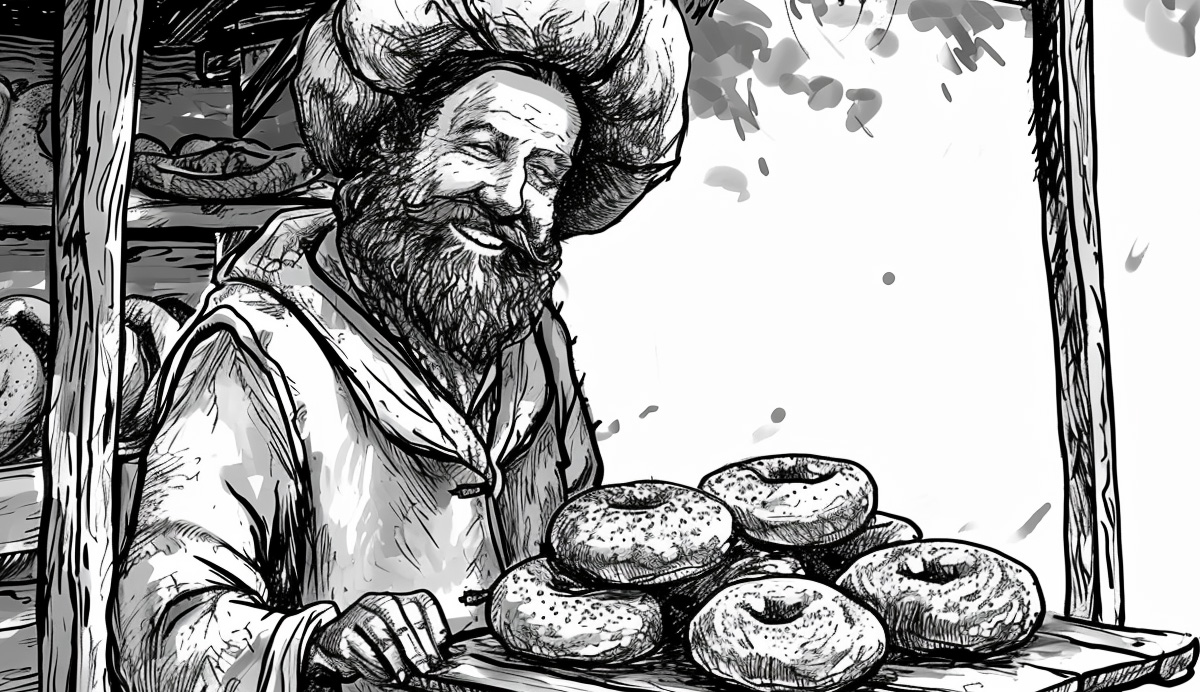
Lean into the cultural significance of cuisine
Each culture in your world can have its unique culinary identity. For instance, a coastal city might have a diet rich in seafood, while an underground Dwarven community might rely on mushrooms and root vegetables. These choices aren’t just about what is available; they’re reflections of history, tradition, and societal values. Elves might prefer delicate, vegetarian dishes reflecting their affinity with nature, whereas Orcs might favour robust, meat-heavy meals.
These details in your campaign are what make food into a storytelling device, revealing aspects of a character’s background or the customs of a particular society.
Economic and geographic influences
Every region can have its specialities and delicacies, which can serve as unique identifiers. These can range from a rare spice found only in a particular magical forest to a special brew for which a monastery is renowned. Such elements can become central to quests (seeking a rare ingredient) or add flavour to your players’ interactions with the world.
The availability and type of food in a region can also speak volumes about its economy and geography. A wealthy city might have a wide variety of foods, including exotic and expensive imports, while a remote village might depend on locally sourced, seasonal produce. Such details can add layers to your world, making it more believable and relatable.

Food as a plot device
There are all kinds of ways you can incorporate food into your campaign to elevate the narrative, offering unique plot devices that bring depth and intrigue to your storytelling. Here are some ideas on how culinary elements can serve as more than just background details, becoming central to your game’s plot and character interactions.
Food in quests and adventures
Quests for rare ingredients: Players can be sent on quests to find exotic or rare ingredients, needed for a royal feast, a magical potion, or to simply stop the dragon from eating everything in the town. This can lead them to unexplored territories, bringing in elements of adventure and danger.
The mystery of the poisoned neal: A classic “whodunit” scenario where a meal becomes a means for intrigue. Perhaps a prominent NPC is poisoned during a banquet, and the players must investigate, leading them into a web of political intrigue and secrets.
Social and political implications
Feasts as diplomatic tools: In the world of D&D, a feast can be more than just a meal; it can be a diplomatic event where alliances are formed or broken. Players can navigate complex social dynamics, engage in subtle negotiations, or even thwart assassination attempts during such gatherings.
Famine and scarcity: Introducing a famine or scarcity of food in a region can create a compelling backdrop for a campaign. Players can be involved in finding a solution, dealing with the social unrest, or investigating the cause of the scarcity, such as a curse or blight.
Culinary discoveries and innovations
Discovery of new cuisines: Players might be the first to discover a new land with unknown foods and cooking methods. This can lead to cultural exchanges, trade opportunities, or even conflicts over resources.
Magical culinary creations: Experimenting with magical ingredients can lead to the creation of unique dishes with special effects. These culinary creations can become sought-after items, either for their taste or their magical properties.
Using food as your plot device can be a welcome change from the tropes of goblins in the woods, the dragons in their liar or the bandit gang terrorising the town. It can be a great way to naturally bring your players into the story, in a way that isn’t being telegraphed and breaking their immersion.
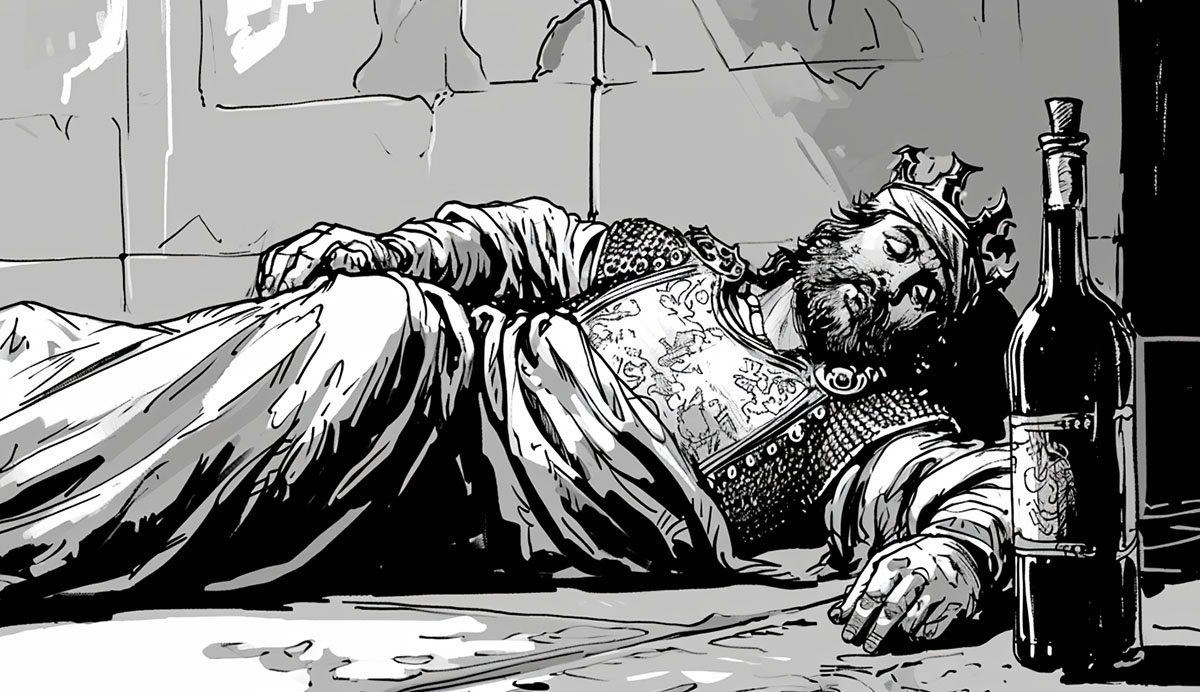
Culinary customs and etiquette
Apart from building quests around food, you can significantly improve your storytelling just by thinking about the details of things like the dining traditions across various races and cultures in your world to provide a backdrop for unique role-playing experiences.
Diverse dining traditions
Elven grace, Dwarven heartiness: Elven meals might be an elegant affair with an emphasis on presentation and natural flavours, while Dwarves could have heartier, communal feasts that reflect their robust nature and love for ale.
Halfling homeliness, Orcish feasting: Halflings could be known for their homely, comforting meals, bringing a sense of warmth and community, whereas Orcish feasts might be boisterous, meat-dominated gatherings that signify strength and fellowship.
Etiquette and social norms
A royal banquet vs. a tavern meal: Contrast the formal etiquette expected at a royal banquet with the more relaxed, sometimes rowdy, atmosphere of a local tavern. This can lead to interesting role-play scenarios where characters must navigate different social expectations.
Cultural faux pas: Introduce scenarios where characters might unintentionally commit a cultural faux pas during a meal, such as using the wrong utensil or refusing a dish, leading to humorous or tense moments.
Religious and magical rituals involving food
Sacred meals and offerings: Detail how certain cultures might have meals that are also religious ceremonies, requiring specific preparations or offerings to deities.
Magic-infused cuisine: Explore the idea of chefs or alchemists who specialise in creating dishes with magical effects, whether for healing, enhancement, or other mystical purposes.
Implementing these details in your campaigns allows your players to engage more deeply with the world and its inhabitants and can lead to memorable moments both humorous and profound. Food can do more than just satiate hunger; it can bring people together, create bonds, and even lead to unexpected adventures.
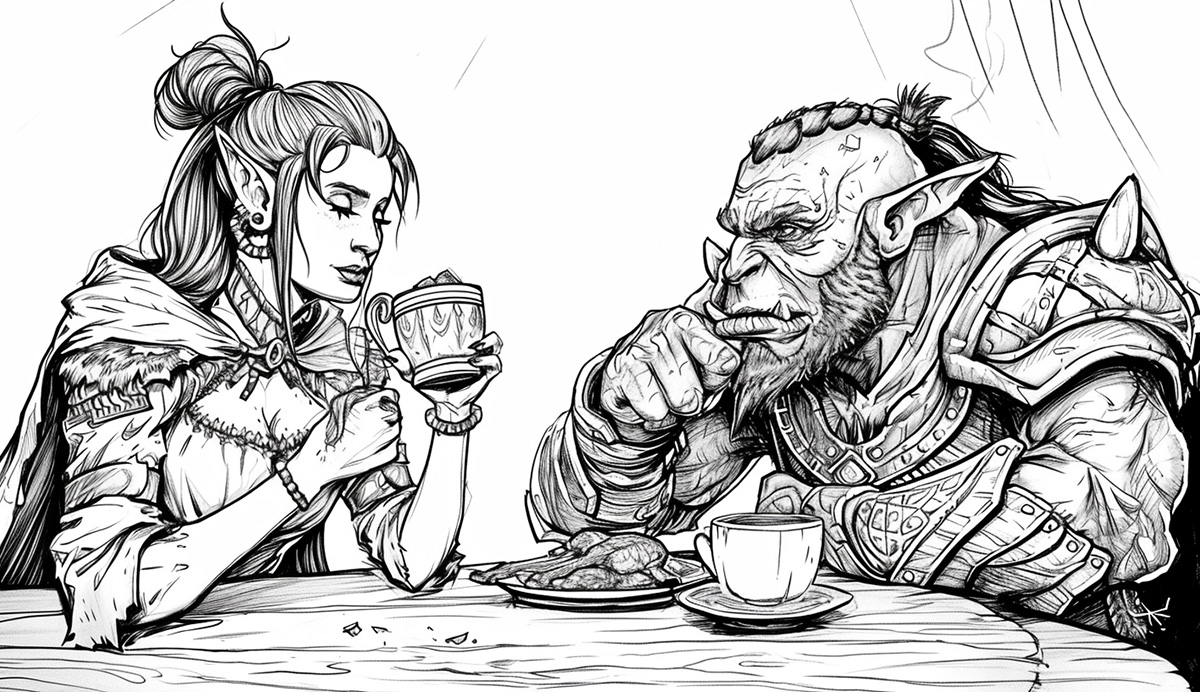
Recipes and potions
As with Barrington and his slightly shady bagels, you can integrate recipes and potions into your campaign, offering both a tangible connection to the fantasy world and an opportunity for players to interact with the game in a unique way.
Fantasy recipes for the gaming table
Cultural dishes: Provide a selection of recipes inspired by the various cultures within your world. For instance, an Elven bread that’s light and nutritious, or a hearty stew common in Dwarven halls. These recipes can be simple enough for players to try making for game nights, adding an immersive element to the sessions.
Seasonal and festive Foods: Suggest ideas for seasonal dishes that characters might enjoy during in-game festivals or special occasions, reflecting the in-world time and cultural significance of these events.
Potions as culinary creations
Edible potions: Shift the traditional concept of potions from just vials of liquid to include edible forms like enchanted cookies, magical broths, or bewitched candies. This adds a playful and imaginative element to potion-making.
Cooking with magical ingredients: Discuss how certain ingredients found in the fantasy world can have unique properties. For example, a rare herb that enhances strength or a mystical fruit that grants temporary invisibility. These can be used in cooking to create dishes with magical effects.
Interactive Culinary Experiences in Gameplay
Cooking challenges: Introduce scenarios where characters must cook a meal to win a competition, appease a deity, or fulfil a quest. This can involve gathering rare ingredients or mastering ancient recipes.
Foraging and ingredient gathering: Encourage players to engage in foraging for ingredients as part of their adventure. This can be tied to survival skills and can lead to discovering unique and magical flora.
Bringing culinary challenges into your campaign can give your players some low-stress “time off” from their main campaign and help you with the pacing. Introducing your own elements like this can especially help newer players who may have their thinking centred on the rules and tropes they have learned and have expectations for.
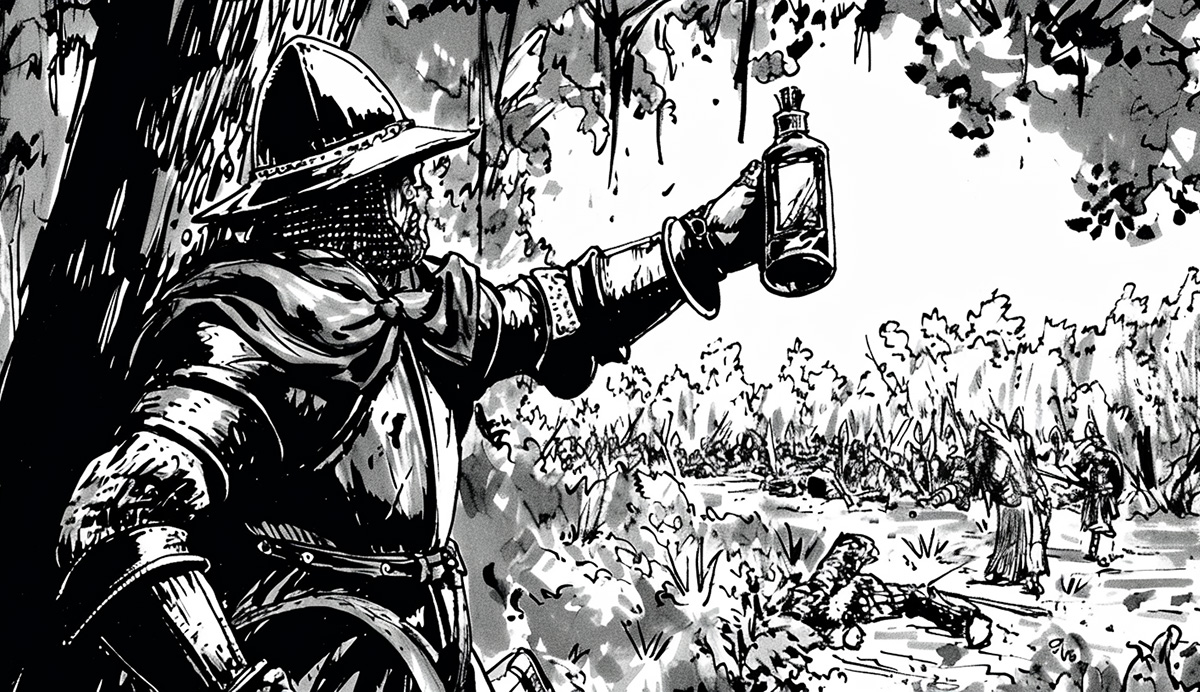
Interactive food encounters
If you want to go “all in” with bringing food into your campaigns, you can consider incorporating interactive food encounters. These encounters allow players to use their skills in new and creative ways, possibly giving them to chance to do something they’ve never done before if they’re used to playing pre-written campaigns!
Cooking as a skill challenge
Culinary skill checks: Introduce cooking as a skill challenge where players can use their abilities in creative ways. For example, a Wisdom (Survival) check to forage for ingredients, an Intelligence (Nature) check to recall rare recipes, or a Dexterity (Sleight of Hand) check for intricate food preparation.
Teamwork in the kitchen: Encourage teamwork by having players collaborate on a cooking challenge. This could involve each character contributing their unique skills to create a feast, forging deeper bonds between party members.
Foraging and Survival
Foraging mechanics: Develop mechanics for foraging that include identifying edible plants and hunting game. This can lead to interesting side quests and can be particularly engaging for nature-oriented characters like Rangers and Druids.
Survival cooking: In scenarios where players find themselves in the wilderness, introduce survival cooking challenges. This can test their ability to make do with limited resources and create meals that provide sustenance and morale boosts.
Culinary quests and encounters
Gastronomic quests: Design quests that revolve around culinary themes, such as retrieving a legendary recipe, saving a renowned chef, or competing in a high-stakes cooking competition.
Food-related social encounters: Use food encounters to facilitate social interactions, whether it’s negotiating with a merchant over exotic spices or impressing a local noble with a well-prepared meal.
Food encounters not only provide sustenance for the characters but also serve as opportunities for creativity, teamwork, and memorable role-playing moments. Remember that food in your fantasy world can be as magical and adventurous as the quests themselves, adding a delicious dimension to your storytelling.
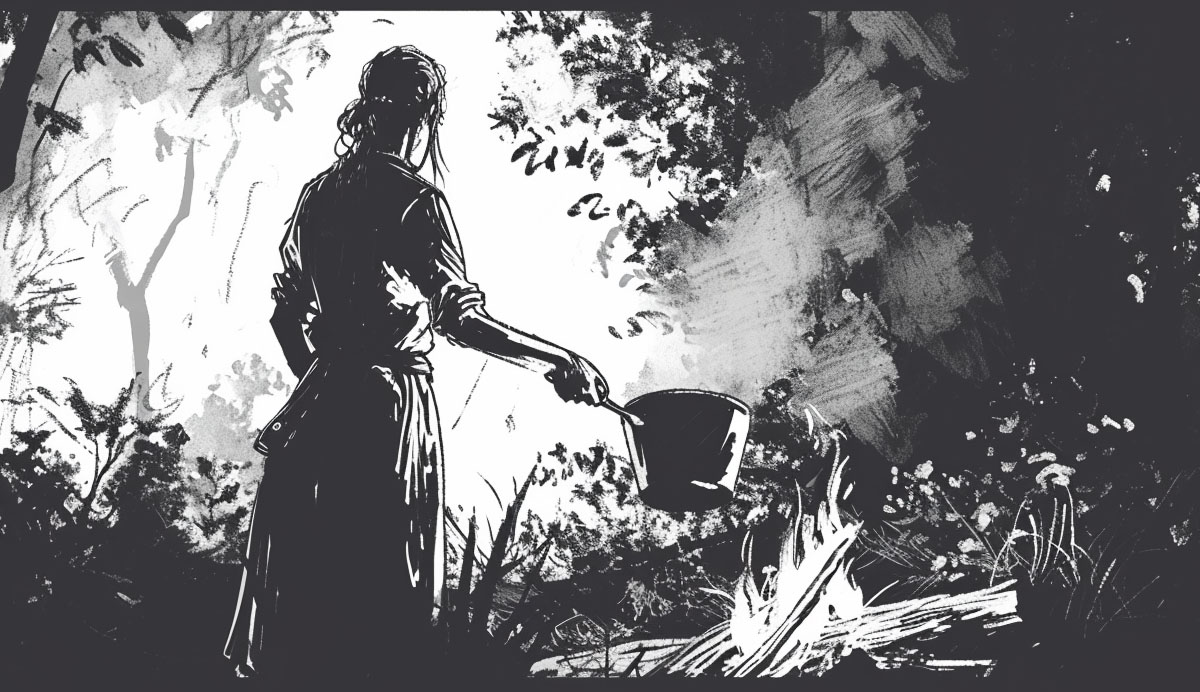
A culinary recap
- World-building through cuisine: We’ve seen how the foods of different cultures and regions can add layers to the world you’re creating, making it more vibrant and relatable.
- Food as a plot device: Culinary elements can serve as powerful tools in driving narrative and character interactions, from quests for rare ingredients to diplomatic feasts.
- Culinary customs and etiquette: The exploration of dining traditions and etiquette offers a platform for unique role-playing experiences and cultural immersion.
- Recipes and potions: The inclusion of actual recipes and magical culinary creations provides a tangible, interactive element to the game, further blurring the line between the players’ and characters’ experiences.
- Interactive food encounters: By introducing cooking challenges and foraging mechanics, players are offered new ways to engage with the game, utilising their skills and creativity.
As a Dungeon Master or player, you have the creative freedom to weave these elements into your adventures in ways that resonate with your gaming style and preferences. Remember, the essence of D&D lies in the shared experience and the stories you create together. So, next time you sit down for a session, consider not just the battles to be fought and the treasures to be found, but also the meals to be shared and the culinary adventures that await.
Happy gaming, and bon appétit!
